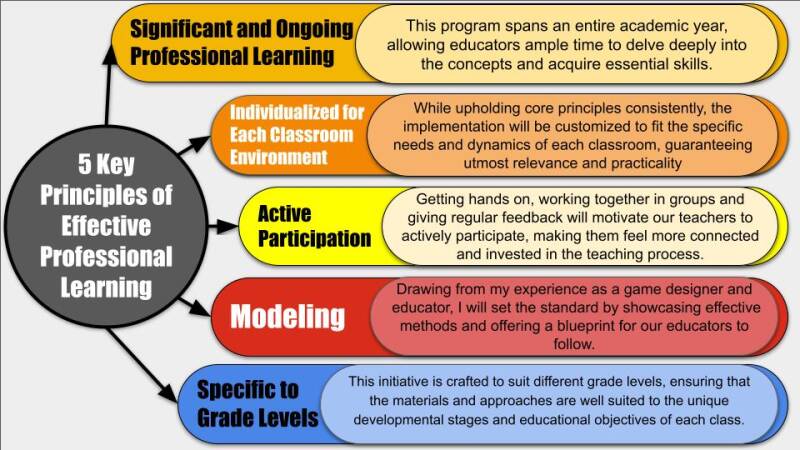5389: Connecting & Communicating Your Ideas

Grounded in the principles of growth mindset and neuroplasticity, I have curated a comprehensive professional development program for educators on implementing a gamified blended learning course in elementary classrooms. This training initiative will span the summer months and continue throughout the academic year, providing ongoing support to teachers as they navigate the intricacies of integrating this innovative course into their instruction. Through active engagement, hands-on practice, and real-world examples, educators will acquire the necessary skills and confidence to effectively incorporate the gamified blended learning course into their teaching practice. Ultimately, this program aims to enhance student learning, foster a growth mindset, and promote an understanding of neuroplasticity, thereby empowering students to embrace challenges, persevere through obstacles, and unlock their full potential!
The professional development plan for this initiative has been meticulously designed to align with the Five Principles of Effective Professional Development (Gulamhussein et al., 2013), ensuring a comprehensive and influential learning journey for our teachers.


Big Hairy Audacious Goal and 5 column Table
My Big, Hairy Audacious Goal (BHAG) for this interdisciplinary gamified blended learning project is for student teams to create high-quality, immersive educational games that effectively teach players about neuroplasticity and growth mindset while providing an engaging gameplay experience. We aim to achieve this by equipping interdisciplinary student groups with the knowledge, skills, and resources needed to seamlessly integrate concepts from game design, biology, and English into dynamic educational games. Our BHAG goes beyond just creating games—it's about cultivating deeper learning competencies like critical thinking, collaboration across disciplines, communication, creativity, and self-directed project management. We envision a future where students are empowered to become innovative game designers, applying their understanding of complex topics like neuroplasticity and growth mindset into captivating digital experiences that revolutionize how these concepts are taught and learned.

Call to Actions
Generating buy-in and mobilizing stakeholders behind this gamified blended learning initiative is pivotal. The key is igniting a sense of urgency around transforming how complex topics like neuroplasticity and growth mindset are taught. Conventional lecture formats often fail to engage students with these abstract concepts effectively. Now is the time to champion a paradigm shift that emphasizes immersive, hands-on learning through educational game development. By advocating for project-based, interdisciplinary collaboration among administrators, teachers, students, and parents, we can uplift experiential curricula that unlock student creativity and ownership of their learning. This approach empowers learners to not just absorb knowledge passively, but to actively apply it through the dynamic process of crafting digital experiences. With robust advocacy and stakeholder alignment, we can implement compelling game-based learning that revolutionizes how neuroplasticity, growth mindset, and 21st century skills are instructed and acquired.
Timeline
Below is a timeline breaking down each of the main sections chronologically with important key points for each one
Alternative Professional Development Plan
Fostering collaboration and effective modeling:
1. Allocating common planning time for content collaboration.
2. Collaboratively developing rubrics, materials and sample projects.
3. Showcasing effective practices through teacher leaders as models.
4. Administrators creating schedules that allow ample time, for collaboration.
Leaders and their roles :
Administrators- Developing schedules. Providing resources.
Department Heads- Lead Professional Learning (PL) Sessions and offer coaching
Teacher Leaders- Demonstrate practices and provide support during sessions
Resources
My Contribution to My own Learning & the Learning Community
Profound growth often stems from the collective journey alongside a supportive learning community. I've been fortunate to be part of an exceptional group dynamic throughout this program. These individuals have been steadfast companions from the very start, serving as a sounding board, providing encouragement, and fostering an unparalleled collaborative environment – the finest I've experienced. To delve deeper into the enriching collaborative sessions we've shared and gain insights into how I've actively participated and contributed, please explore the details by clicking the button below.
Create Your Own Website With Webador